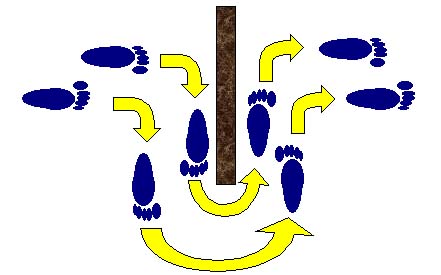Neuroethology
Lecture 28 - Programs
for Movement (ii): Things get complicated

Required Reading : Chapter
7 - Simmons and Young
Enter stage right - Sensory
Input
The central pattern generator involved in
locust flight receives input from two main sensory systems which,
combined, monitor the elevation and depression of the wings.
The wing hinge stretch
receptor
- single receptor cell embedded in elastic
strand
- spans the wing hinge
- excited by elevation of the wing
The tegula
- chordotonal organ within a cuticular pad
- pad bears several stout hairs
- excited by depression of the wing
Other movements are also monitored - wing
veins carry campaniform organs which measure forces on the wings
Integrating sensory input
The stretch receptor excites the ipsilateral
depressor motor neurons. Removal of stretch receptor input causes
a drop in the flight rhythm. In contrast, the tegula excites the
ipsilateral elevator motor neurons. The elevator motor neurons
have two phases of excitation during each wing beat - input from
the tegula precedes excitatory input from thoracic interneurons.
 Central pattern generator output and proprioceptor feedback
loops combine to provide a flexible motor pattern that allows
for correction of heading during flight. The figure above shows
how a locust can use feedback about the timing of its wing beats
to correct for an artificially induced change in heading.
Central pattern generator output and proprioceptor feedback
loops combine to provide a flexible motor pattern that allows
for correction of heading during flight. The figure above shows
how a locust can use feedback about the timing of its wing beats
to correct for an artificially induced change in heading.
Straighten up an' fly
right (a question of steering)

The thoracic ganglia receive input from
20-30 DN neurons on either side of the brain. Often these
neurons are multimodal, carrying information about changes
in heading from more than one sensory system at the same time.
- hairs between the compound eyes that are
sensitive to wind
- the ocelli (simple eyes), which
monitor the horizon position
- the compound eyes (for obvious reasons)
- proprioceptors that monitor movement of
the neck joint
The tritocerebral commisure
giant(TCG to its friends)
- wind-sensitive DN neuron
- during steady flight the TCG bursts in
time with wing elevation (rhythmically active)
- stimulating TCG can re-set the flight
motor pattern - is involved in CPG
- TCG is excited by a rush of wind over
the head, so may be involved in initiating the flight motor pattern
after jumping
- left and right TCGs stabilise flight relative
to wind direction
- if the locust yaws so that it is not facing
into the wind, one TCG increases its firing rate and the other
decreases
- stimulating one TCG can cause a locust
to yaw during tethered flight
Another DN neuron: the
DNC neuron(why DNC? who knows!)
- the DNC receives input from wind receptors
and the visual system (probably both the ocelli and the compound
eyes)
- responds to rotation of the visual horizon
- rolling about the long axis
- inputs from wind-sensitive and visual
pathways sum, so that straight flight causes tonic excitation
of DNC
- each DNC is excited by stimuli indicating
a roll to the contralateral side, and inhibited by a roll to
the ipsilateral side
- exciting the DNC causes a corresponding
shift in the left-right phase relationship of the flight motor
neurons, and also causes the head to roll

This figure shows the location of the DNC
neuron in the brain, with its arborisations in the 2nd and 3rd
thoracic ganglia (a). (b) shows the increase in firing rate and
corresponding inhibition as an artificial horizon rolls from side
to side. (c) shows the effect of the DNC upon a pair of flight
muscles (127), which change their relative phase difference when
DNC is stimulated. This indicates the role of DNC in correcting
for rolling movements during flight.
The moral of the story
is...
- circuits of interneurons can use cycles
of inhibition and excitation to create rhythmic firing patterns
- these firing patterns can be used to coordinate
repetitive movements
- the integration of sensory input
is also essential for robust, flexible motor output appropriate
for complex environmental conditions






